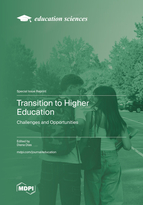Transition to Higher Education: Challenges and Opportunities
A special issue of Education Sciences (ISSN 2227-7102). This special issue belongs to the section "Higher Education".
Deadline for manuscript submissions: closed (31 January 2023) | Viewed by 24839
Special Issue Editor
Interests: students academic success and integration process; learning outcomes; competencies assessment; quality assurance; access and equity; comparative analyses of policies systems; students choices and mobility; academic satisfaction and engagement
Special Issue Information
Dear Colleague,
The transition to higher education (HE) is a significant life event that is supposed to be a very pleasant experience for students. However, the impacts of this transition are not straightforward, being influenced by students’ psychosocial variables and by their own perceptions concerning the HE environment.
The transition to HE encompasses many tasks requiring students to cope with changes, deal with new kinds of responsibilities, and manage emotions. A wide variety of emotions take place in the HE transition, both positive and negative in nature, such as joy following enrolment success and fear related to social rejection.
This Special Issue is focused on the transition to HE, focusing on first year students’ personal and developmental variables. Articles that may contribute to scientific advancements in this area will be considered for publication, allowing readers to reflect on scientifically rigorous and innovative investigations.
Dr. Diana Dias
Guest Editor
Manuscript Submission Information
Manuscripts should be submitted online at www.mdpi.com by registering and logging in to this website. Once you are registered, click here to go to the submission form. Manuscripts can be submitted until the deadline. All submissions that pass pre-check are peer-reviewed. Accepted papers will be published continuously in the journal (as soon as accepted) and will be listed together on the special issue website. Research articles, review articles as well as short communications are invited. For planned papers, a title and short abstract (about 100 words) can be sent to the Editorial Office for announcement on this website.
Submitted manuscripts should not have been published previously, nor be under consideration for publication elsewhere (except conference proceedings papers). All manuscripts are thoroughly refereed through a double-blind peer-review process. A guide for authors and other relevant information for submission of manuscripts is available on the Instructions for Authors page. Education Sciences is an international peer-reviewed open access monthly journal published by MDPI.
Please visit the Instructions for Authors page before submitting a manuscript. The Article Processing Charge (APC) for publication in this open access journal is 1800 CHF (Swiss Francs). Submitted papers should be well formatted and use good English. Authors may use MDPI's English editing service prior to publication or during author revisions.
Keywords
- transition
- higher education
- first year students
- organizational goals






